With the mudras as given by the Brotherhood of the Midnight Sun
Being a ritual of alignment to the Aeon for the Ophidian Thelemite, to be used four
times daily and before other works of Heka.
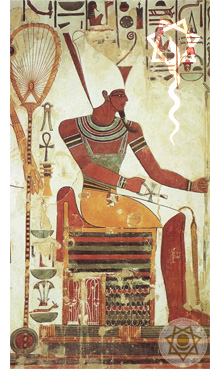
The
God Tum, speaking from the Triangle of Manifestation:
Tum: "The Wisdom comes in the front. Sacre toom num dum – num dum dare. Sail on
the waters of your questions. Tum non dave.. da-vay."
T: "Kephra carries the Midnight Sun – you awakened it – why? Do you seek your brotherhood?
The Midnight Sun."
T: "The stone’s been moved. The light’s shown in. The light of the Sirus Star."
T: "Do what thou wilt shall be the whole of the law. Love is the law, love under
will. Can you state your Will?"
X: "My Will, is to establish the Cult of the Great Liberating Mother, and to help
with it in any way that I may – or die trying."
T: "Then you seek the Brotherhood of the Midnight Sun. Ka-ke kee-oh-ku keph-ra.
... [edited section to maintain oaths, Temple secrets, etc.]
Do you know the name of the night birds of Egypt?"
X: "No."
T: "They speak for Kephra because Kephra has no tongue. That would be the hieroglyph
key-yo… key-yo… key-yo." [Saying it sing-song like a bird call] And the sistrum.
Now you understand."
X: "Yes."
T: "The sound of the beetle. Chica-chica-chica-chic-chic-chihc-chic. [Saying it
like a sistrum sound] Can you say Resh to Tum?"
X: "Tum… evening?"
[Affirmative nod. X does the evening Adoration as instructed.]
T: "So if you have made a door into my house, how do you know of me? You do know
that it is of the water?
Which is why I said to ride the waters of your questions."
X: "What does your name mean?"
T: "It is most similar to your element – water."
X: "Sometimes the books call you Atum instead of Tum."
T: "It is different – it is the water moving."
X: "Do you make open the way to the Midnight Sun?"
T: "It is a channel – I lead to it in the evening. Kephra can not speak."
X: "Is Kephra the Midnight Sun?"
T: "Kephra carries the midnight Sun."
X: "Then what is the Midnight Sun, and this Brotherhood?"
T: "The Moon.
The Brotherhood of Service – the Army."
...
T: "Those are your Brothers."
X: "Who are ‘those’?"
T: "Those who seek the same thing."
X: "And what is Khonsu then? Is he not the Moon too?"
T: "You asked about Ankh-af-na-Khonsu.
X: "Yes I did."
T: "What does it mean if you translate that?"
X: "Would it be ‘Life of the Moon’?"
T: "Khonsu."
X: "‘Life of Khonsu’."
T: "The Force, of Life." [meaning the Ankh. The Spirit]
X: "Are we invoking the Genius of Ankh-af-na-Khonsu into us? [By performing Resh
are we invoking the Genius of the Historical Ankh af na Khonsu, the person, into
us]"
T: "Would not the Priests of Khonsu be the Brotherhood?"
X: "Yes"
T: "Then would you not be Ankh-af-na-Khonsu, in one sense?"
X: "In what sense?"
T: "Because you are in Life."
X: "Yes."
T: "There’s not one Ankh-af-na-Khonsu - but there is... not many. That’s the Brotherhood."
...
T: "You are preparing for the Three Days?"
X: "We are."
T: "There may be more to come in the next day."
T: "This day. Note this day and why I came, for your timing." [4 days before the
Three Days. The Moon was in the 8th Mansion. In Coptic it is called Termelia. "The
Descent" into the Waters of the Underworld.]
T: "And this symbol." [makes symbol or mudra of Tum with hands, see below]
X: "What is that."
T: "My symbol."
X: "The Crescent Moon?"
T: "The same as Khonsu, reflected in the water.
So at one point when you learn all of the symbols, when you do Resh you can make
them with the names." [showing each symbol with hands - see below] "Also the Moon,
with horns, like that..."
T: "Those others that you did – what is that?" [The Golden Dawn degree signs]
X: "Those were learned from a modern group called the Golden Dawn who were copying
images from papyri from Egypt, what they thought were different images of the Gods
standing in certain ways as pictured on walls."
T: "What does it have to do with this?"
X: "Nothing"
T: "So this is instead."
X: "Yes."
T: "That makes Ra Hoor happier."
...
T: "Now you know the secret door into the house of Tum. The Stone has been Moved."
[The Stone which seals the Pyramid, tomb, or burial chamber.]
T: "You would not have begun this path if it was not the right time."

Such was the way in which the God Tum introduced us in the Temple to the proper
expression of the Adorations of Ra Hoor Khuit, popularly called Resh by the modern
followers of Crowley. In our Temple, we perform the "long" versions of the Adorations
to Ra Hoor Khuit four times a day: Sunrise, Noon, Sunset and Midnight. This is not
so uncommon as many people do this. But what is uncommon is the expression and attitude
one has in one's Persona towards one's Spirit when reciting the Adorations. The
Mudras given by the Brotherhood help tremendously in this regard. In addition, it
is important to understand all of the players which are mentioned in the Adorations,
and why they are there. Most people have some grasp of who Ra Hoor Khuit is, or
his father Ra. But few have much of an understanding of Khonsu or Mentu in relation
to their presence in the adorations. We hope to be able to help in this regard.
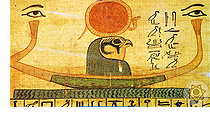
But first, let us give the text of
the Adorations, with the proper placement of the Mudras therein. The adorations
were written by Crowley as his poetic translation of the Stele of Revealing, and
included in the Book of Law at the behest of the Gods during its reception. Only
part of this translation was used and can be found in Chapter III verses 37-38 of
Liber Legis. When reciting the text as worship to Ra Hoor Khuit and the other Gods
which cluster to support him, it is divided into two parts. The first part changes,
depending upon which time of day one is performing the worship. The second part
is longer, and is always said in the same way, no matter which time of day it is.
Here then is the text with the insertion of the Mudras (hand symbols).

(Morning, facing East with Ra Mudra which is held until the next one is reached
at "Tahuti".)
Hail unto thee who art Ra in thy Rising, even unto Thee who art Ra in Thy Strength,
who travellest over the heavens in Thy bark at the Uprising Hour of the Sun. Tahuti
(make mudra) standeth in His splendour at the prow, and Ra-Hoor (make mudra) abideth
at the helm. Hail unto Thee from the Abodes of Night.
(Noon, facing South with Hathoor Mudra which is held until the next one is reached
at "Tahuti".)
Hail unto thee who art Hathoor in Thy triumphing, even unto Thee who art Hathoor
in Thy Beauty, who travellest over the heavens in Thy bark at the Noon Hour of the
Sun. Tahuti (make mudra) standeth in His splendour at the prow, and Ra-Hoor (make
mudra) abideth at the helm. Hail unto Thee from the Abodes of Morning.
(Evening, facing West with Tum Mudra which is held until the next one is reached
at "Tahuti".)
Hail unto thee who art Tum in Thy setting, even unto Thee who art Tum in Thy Joy,
who travellest over the heavens in Thy bark at the Downgoing Hour of the Sun. Tahuti
(make mudra) standeth in His splendour at the prow, and Ra-Hoor (make mudra) abideth
at the helm. Hail unto Thee from the Abodes of Day.
(Midnight, facing North with Kephra Mudra which is held until the next one is reached
at "Tahuti".)
Hail unto thee who art Khephra in Thy hiding, even unto Thee who art Khephra in
Thy silence, who travellest over the heavens in Thy bark at the Midnight Hour of
the Sun. Tahuti (make mudra) standeth in His splendour at the prow, and Ra-Hoor
(make mudra) abideth at the helm. Hail unto Thee from the Abodes of Evening.
(Then recite the following no matter which time of day.)
(Begin Mentu Mudra which is held until the word "truth" is reached, then transform
to Ra Hoor Khuit Mudra at the invocation of his name. Hold this until the words
"Appear on the Throne of Ra".)
I am the Lord of Thebes,
and I The inspired forth-speaker of Mentu;
For me unveils the veiled sky,
The self-slain Ankh-af-na-khonsu
Whose words are truth. I invoke, I greet
Thy presence, O Ra-Hoor-Khuit!
Unity uttermost showed!
I adore the might of Thy breath,
Supreme and terrible God,
Who makest the gods and death
To tremble before Thee:—
I, I adore thee!
(Begin Throne of Ra Mudra which is held until “house of Ra”.)
Appear on the throne of Ra!
Open the ways of the Khu!
Lighten the ways of the Ka!
The ways of the Khabs run through
To stir me or still me!
Aum! let it fill me!
(Transform to mudras of Ra, Tum, Kephra, Hathoor and Mentu as the names are said.
Hold Mentu until "Ankh-af-na-khonsu" is said.)
The light is mine; its rays consume Me:
I have made a secret door
Into the House of Ra and Tum,
Of Khephra and of Ahathoor.
I am thy Theban, O Mentu,
The prophet Ankh-af-na-khonsu!
(At "By Bes-na-Maut" bring both fists together at chest. For Ta-Nech move both hands
out in front of face, palms slightly apart and facing each other. For Nuit move
the arms outstretched to the stars, palms up. For Hadit move the palms back together
and pull down over the third eye. Then transform this into the Ra Hoor Khuit Mudra
with the worlds "Abide with me..." and hold it in meditation in silence afterwards.
Finish with sign of Silence.)
By Bes-na-Maut my breast I beat;
By wise Ta-Nech I weave my spell.
Show thy star-splendour, O Nuit!
Bid me within thine House to dwell,
O winged snake of light, Hadit!
Abide with me, Ra-Hoor-Khuit!
(Give the Sign of Silence)
 The Mudra of Ra Hoor Khuit, to be held out in front of face.
The Mudra of Ra Hoor Khuit, to be held out in front of face.
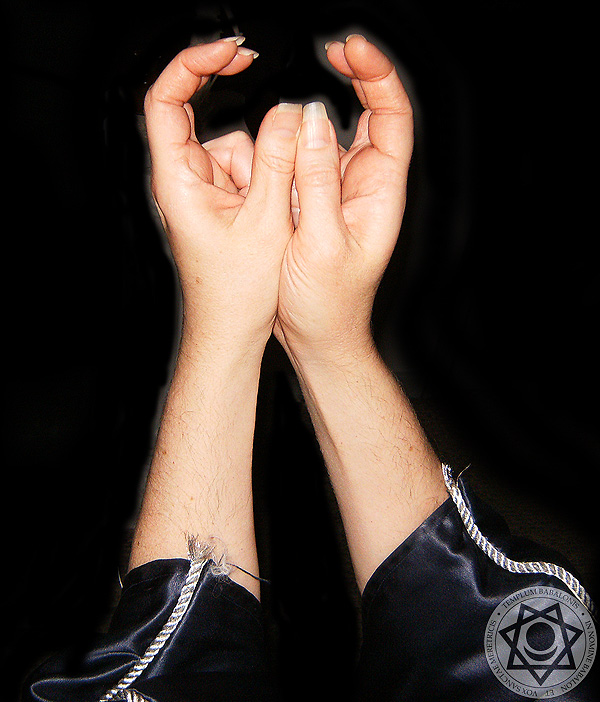
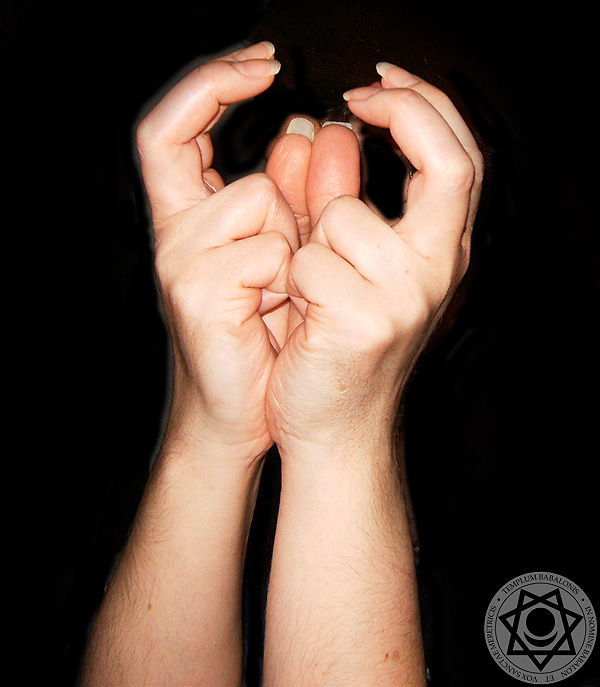
The Mudra of Ra, to be held out in front of and above the head
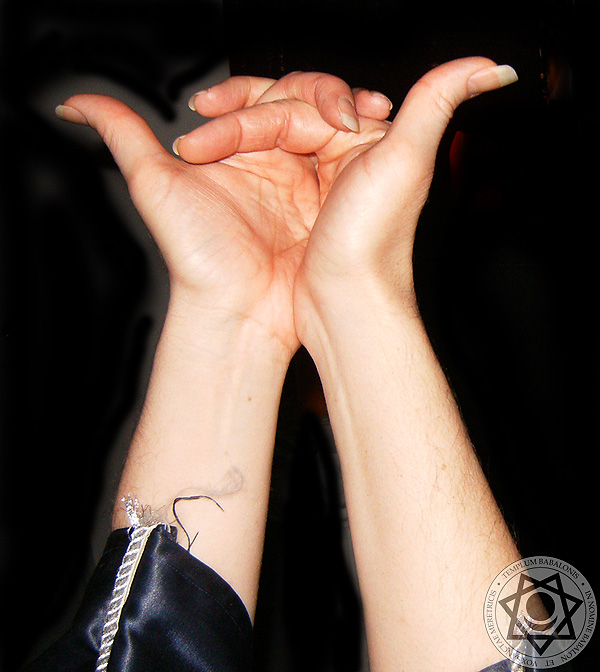
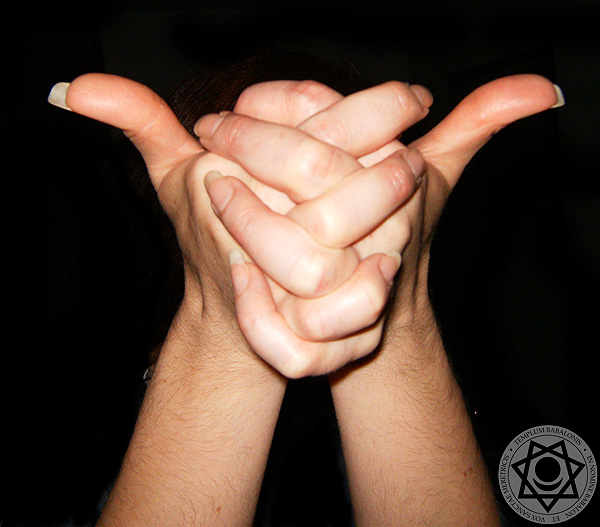
The Mudra of Hathor, to be held out in front of face.
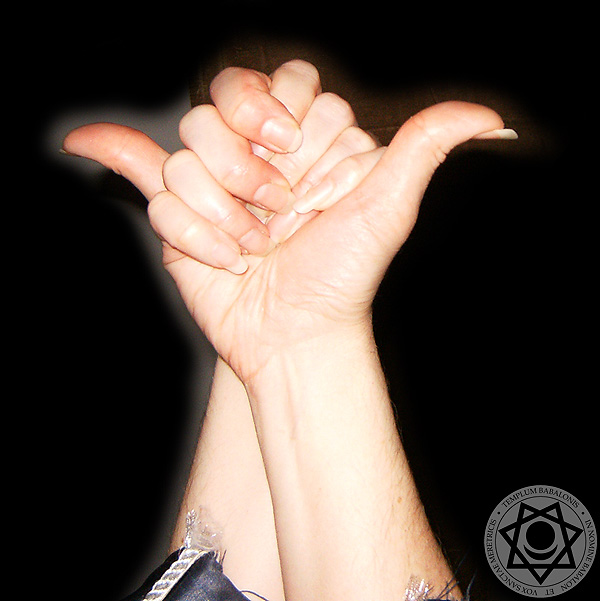
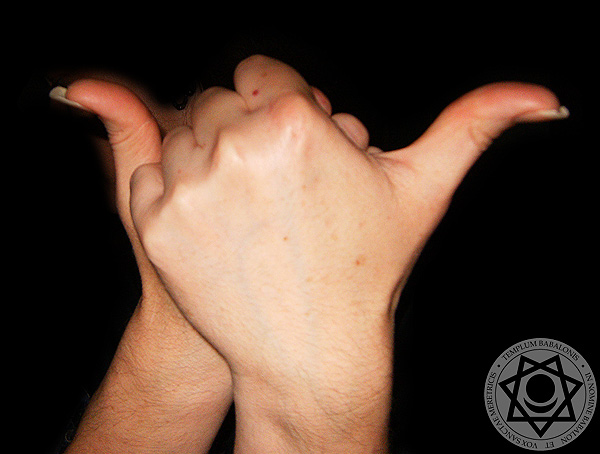
The Mudra of Tum, to be held resting at the waist.
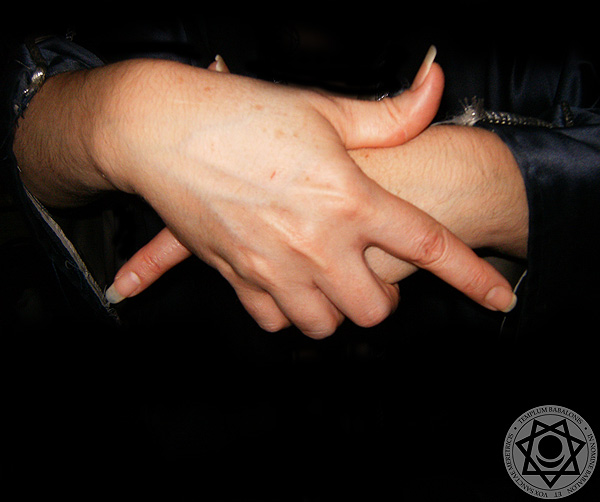
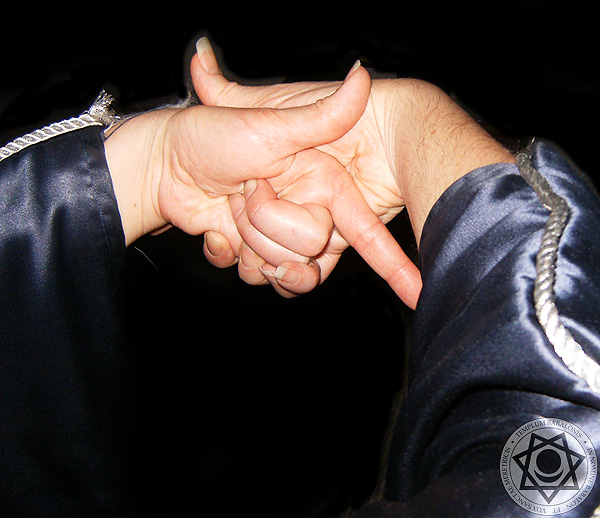
The Mudra of Kephra, to be held out in front of face.
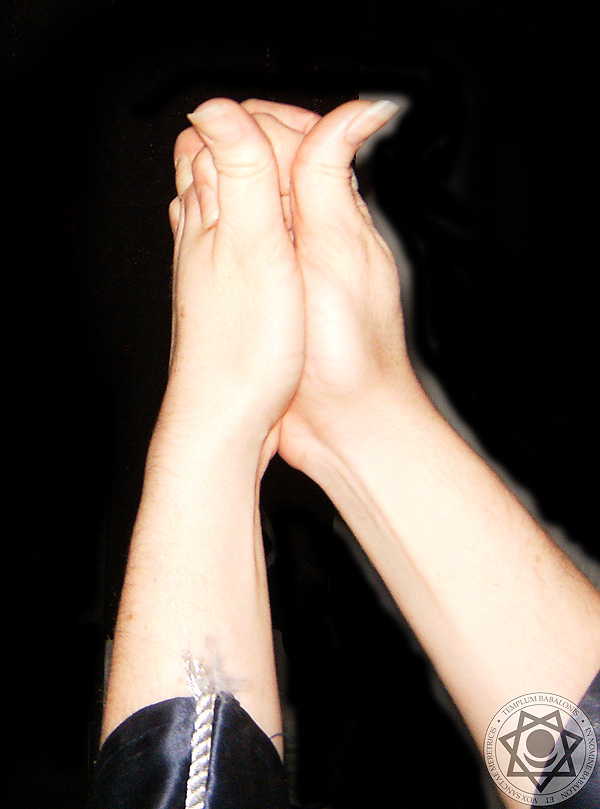
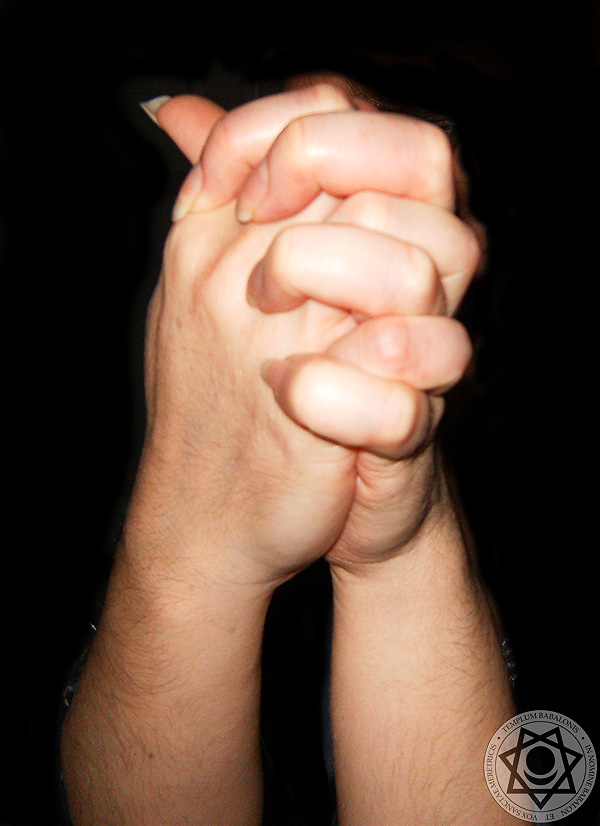
The Mudra of Tahuti, to be held out in front of the chest.
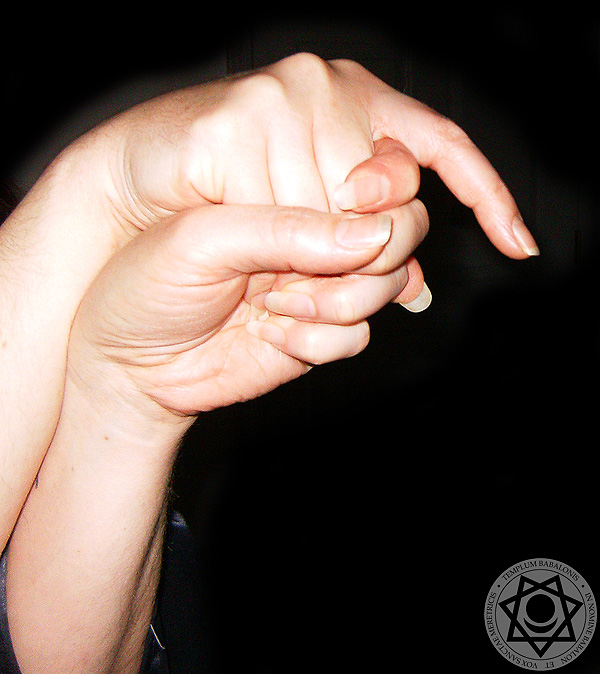
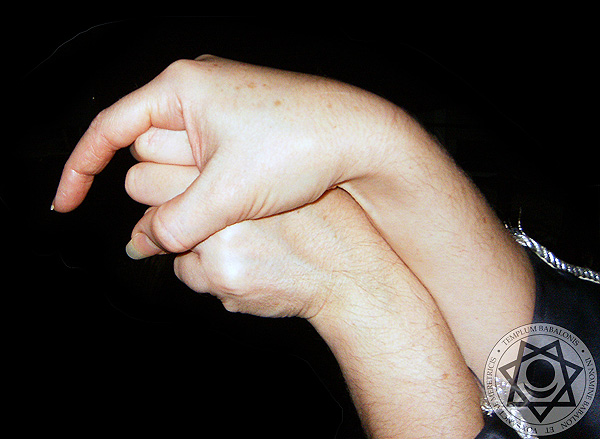
The Mudra of Mentu, to be held out in front of face.
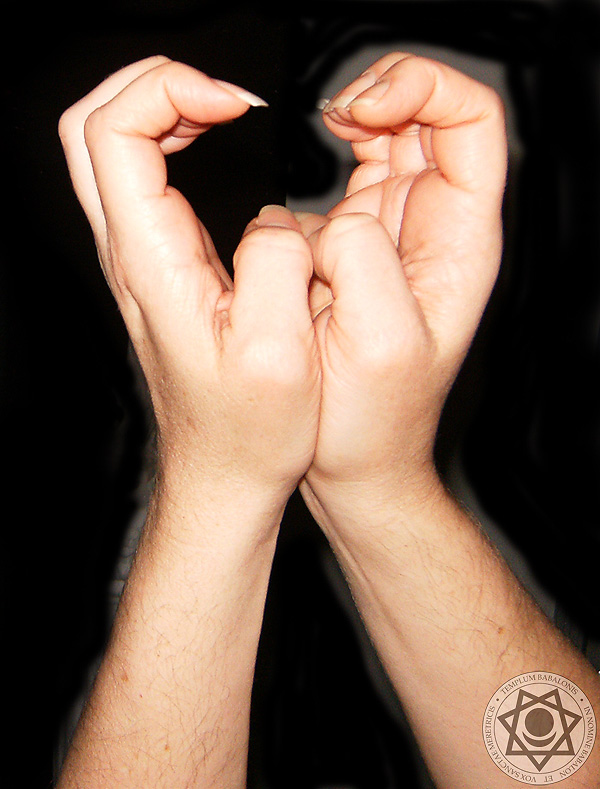
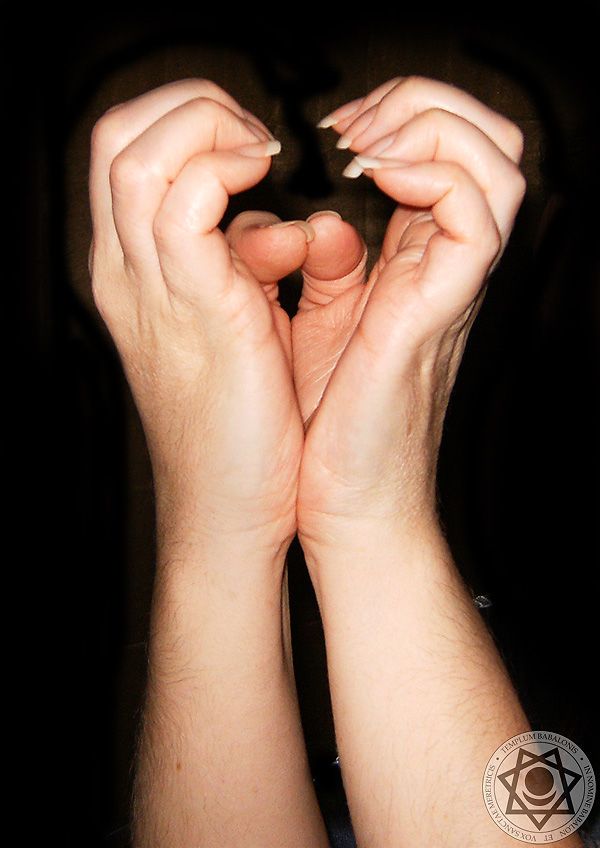
The Mudra of the Throne of Ra, to be held slightly out in front above head, as if
holding the sun disk.
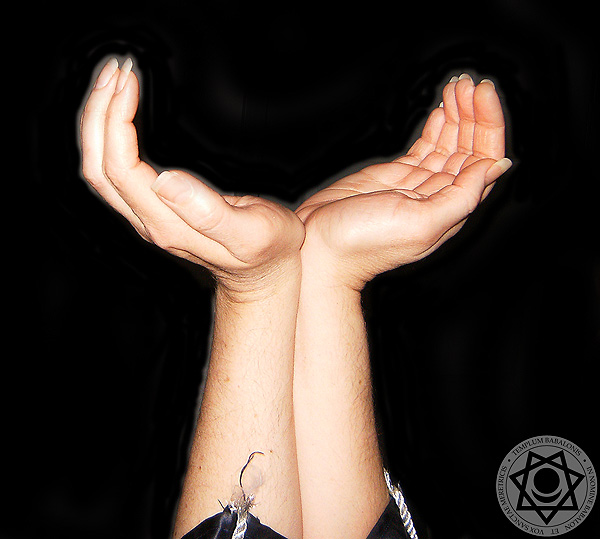

This is the way in which the Four Gates to the One Palace are opened. The Adorations
and the Mudras will help, over time, to prepare one to open these Gates, but the
Gates then are ultimately only opened by the Gods during Initiation of the student.
For the Four Gates are the Four Elements within the Persona, and the ways in which
they function there within Heka are important. And the One Palace is the Spirit
- that which is manifested by means of Heka.
Now this process of Initiation into the Four Gates is cognate with the Four Realms
of the Underworld, which are themselves divided many different ways - often again
by seven (which incidentally leads one to the Realms of the 28 Mansions of the Moon,
which are the stations of transformation in the Underworld). Now it is the Gates
to these Underworld Realms from the manifest Realm of the Living which are guarded
by Ra Hoor Khuit himself. He is the prime Initiator. He is the Guardian to His Sister’s
Realm in the Underworld. He is the Brother to all of the Daughters of Ra. All of
this is very technical, but for our purposes here, He is the prime Guardian and
Initiator of these Gateways. "Four Gates" equals 120 in the English Kabbalah which
we Ophidians use, as does "Ra Hoor Khuit". So too does "golden path", which is the
name of the Hagia, "Aureavia" - and as a Daughter it is that particular Golden Path
which She now lays before the people at this point in time of the Aeon. 120 is also
"black stone" , which is a very important stone from history, last in our possession
in the Temple of Kybele in Rome, and which now probably sits defiled in the cornerstone
of Mecca. This is the "Stone which was moved", in the teachings given by Tum Himself
in the ritual text given above. 120 is also "star fire", which is the source of
the One Palace, the Spirit itself. For it is from the fire of a Star that each Spirit
is born, eternal. Liber Legis I,3 "Every man and every woman is a star." There are
many other associations with 120 as well, but suffice it to say that this is an
indication of Ra Hoor Khuit’s function as the Guardian of the Gates of the Initiations
into the Underworld.
"My lord initiating be O so present among us. Thy feathered wings expanding tip
to tip to cover the horizon. Sing forth O great hawk-headed lord for thy call brings
terror to the hearts of those that hear your battle cry. And as your tail flicks
and your shadow covers them in darkness, they will remember that your fury is not
yet known but only hinted at, as the shroud of the night star light surrounds them."
In these words, which in part form the beginning paragraph of a longer invocation
taught to us by Ra Hoor Khuit Himself, he mentions his wings touching the Horizon,
tip to tip. He covers all four Gates in this way as the Guardian of those places
of egress into the Underworld. And the phrase "tail flicks" also equals 120. The
image of the shadow covering them in darkness, and the emergence of the night star
light is also an image of the descent into the Underworld for those who have undergone
his Ordeals and passed the threshold.
The One Palace, which is the Spirit, and its relation to the Four Gates or Elements
has already been explained in Book II, Chapter 1 of the Magickal Philosophy of Templum
Babalonis. But it should also be mentioned that when Ra Hoor Khuit states that he
is the "Warrior Lord of the Forties" in Liber Legis III: 46, that in one respect
he is again referring to the One Palace. Both "one palace" and "forties" equals
114. This can also be read as the number of Heka or Magick (11) acting upon the
four elements (4). But it should also be noted that the Forties and the Eighties
referred to in this verse mainly refer not to this "one palace", but rather it refers
to the Prophecy of the Shuddering, the War, and the earth changes which are currently
afoot on this planet, which only became apparent to the masses at the events of
9-11-2001 and after. Liber Legis III, 46 "I am the warrior Lord of the Forties:
the Eighties cower before me, & are abased. I will bring you to victory & joy: I
will be at your arms in battle & ye shall delight to slay. Success is your proof;
courage is your armour; go on, go on, in my strength; & ye shall turn not back for
any!" It is interesting to note that George W Bush, Osama Bin Laden, Saddam Houssein,
Twin Towers, "God the Adorer", "blood begins", and many other important names and
phrases all equal the same value as the word "eighties", which is 140. So now you
know who the "eighties" are, even if you do not know yet who actually controls them,
as we were told in this Temple back in 2001 and 2002. We will not release the identity
of the "forties" either, because the War is just getting underway here upon this
planet. We will do so only after they arrive for all to see.
But to return to our subject at hand, in the text of the Adorations the Four Gates
to the One Palace are also signified by the Gods of the four positions of the Sun
during its passing through the sky: Ra, Tum, Kephra and Hathoor. Ra should not be
seen only as he historically is now in the context of an Aryan creator-god who is
the head of the Egyptian Pantheon, but rather also as the living orb of the physical
Sun itself in a way that science and history do not yet understand. And it is in
his different positions during the day one can see the different stages of Spirit
as it goes on its journeys through its various manifestations in life and death.
These are the Sun in his different manifestations. He is Ra in his Rising and the
element of Air as the Sun rays break over the Horizon of Night, each and every morning.
This is the Birth of the Light (the Spirit), into matter. At noon this Light of
Ra shines the brightest, and manifests His temporal Power through the Daughters
of Ra. Hathor is one such Daughter, a sister to Babalon when She was in Her Egyptian
incarnation. It is through the Tu, Her Bull form, that this pure power of the Fire
of Life is manifested into the material Realm. And of course as we have already
shown in Book II, Chapter 2 of the Magickal Philosophy of Templum Babalonis, this
imagery of the bull with its horns is not only the image of the waxing and waning
moons, but the image of the womb itself which is the seat of the power of manifestation.
In the Evening the Sun descends to the Waters and to Tum, the Gateway to the Underworld
in this Solar journey. This is the death of the Sun on its journey. And of this
process Babalon once spoke:
Babalon: "When Hathor descends into the water, do you know what comes back out?"
X: "Mist?"
B: "A serpent."
X: "I did not know that."
B: "The winged serpent."
X: "What is the winged serpent?"
B: "When a spirit ascends. When the serpent in the picture is like this, it is the
transformation in the water."
X: "What does that mean?"
B: "The place between death and birth."
B: "Does it feel – this change – that you are about to be born in your new life?"
X: "Yes."
B: "Then it is like Hathor going under the water and coming out the winged serpent
in the ascendance. Which in your words about the space is the milky way – in the
stars."
Concerning this place of Evening, of Death, of the Opening to the Underworld in
the Solar Cycle through the Element of Water, a bit more was said by Tum, himself:
Tum: "If the Midnight Sun is in the water, then it could be seen as being the Underworld
and therefore Anubis guards the opening to it in this stone that’s been moved. This
you see?"
X: "Yes."
T: "For when they open the tomb, they see Anubis guarding the opening – yes?"
X: "Yes."
T: "Then a True Brother could pass that opening and go past Anubis unscathed. But
a not true brother would not be so fortunate."
T: "Then you shall talk to Anubis about seeing the Trueness of a Brother. And if
a brother who’s not true, then you know where he goes."
X: "To the mumbler? [Set – I did not want to say his name.]"
T: "Hm?"
X: "The One who Mumbles?"
T: "Setesh."
M: "Yes. The Void."
T: "Then you talk to Anpu."
T: "Now."
And there we must stop, for the instructions by Anpu on how to test a True Brother
are not meant for the world to see.
So from Death in Water and in the Evening the Sun travels on its journey through
the Underworld. It is here that it can no longer speak, as Kephra bears it through
the place of darkness and transformation. This is the place of unmaking, and the
place of conception - both in the deepest darkness of the Womb itself. Kheper Ra
is the name of the Sun here, “the coming into being of Spirit”. It is here that
the greatest of all Heka takes place.
On this journey of his Father, Ra Hoor Khuit has said:
"The Sun is born and dies each day,
And the Moon each month.
Both are born again, but the Moon always in blood,
And the Sun always of darkness."
And why is it that during this journey it is said that "Tahuti standeth in His splendour
at the prow, and Ra-Hoor abideth at the helm"? You may ask what are they standing
in and why? The answer is the Boat of Millions of Years, which is also called the
Boat of Ra. This is the vehicle which carries the light on its journey through these
cycles of death and rebirth. In other cultures it was seen as a chariot, but here
in Egypt it is a boat, because it travels through the Cosmic Waters of the Primordial
Nu, the source of All Things. Sisi, the Ape of Thoth, had this to say concerning
this arrangement of Gods in the Boat of Millions of Years:
Sisi: "What is the relationship of Tahuti and Ra Hoor Khuit? They both see. But
one sees one direction and one sees another."
S: "If Ra Hoor faces forward, what you would say forward in the boat, towards the
Light of Ra, Tahuti sees what you would say backwards into the darkness. One of
life, one of death."
So one can see into the world of life (Ra Hoor) and one can see into the Underworld
(Tahuti). That is why the Adorations mention them, and you invoke them as guides
and guardians into your life for the same reason every time you say the adorations.
Now we come to the Theban section of the Adorations.
"I am the Lord of Thebes, and I
The inspired forth-speaker of Mentu;
For me unveils the veiled sky,
The self-slain Ankh-af-na-khonsu
Whose words are truth. I invoke, I greet
Thy presence, O Ra-Hoor-Khuit!"
The Lord of Thebes is the god popularly named Mentu. In this function he is the
most ancient Bull God, guardian of the Priestesses of the Womb, the Ta, from an
ancient time. He is Men Tu. The Man Bull. The Tu guards the Ta. The Bull guards
the Womb. In Aryan times in Egypt he is pictured almost like Ra Hoor Khuit as a
Falcon God, but he was originally a Bull Beast, which is to say a Guardian of the
Goddess. The Beasts of the Great Liberating Mother always appear as Lions, Monsters
and Bulls of various sorts. Phonetically Montu, MNT, is not far historically from
another Son of the Goddess named Minotaur (MNTR) who served the same function in
a different land. Now Thebes has both a Warrior Lord as Falcon in Mentu, as well
as a boy-child God in Khonsu. This mirrors the relationship between Ra Hoor Khuit
and Hoor Par Khart, who is Horus the Child. Mentu is a Solar God while Khonsu is
Lunar. It is interesting to note that Mentu in later Egyptian means "traveller"
while Khonsu means "wanderer". The Moon God is often called "wanderer" or "shepherd"
in many cultures, because of its path through the sky which deviates from the other
stars. But the important point here is that you have two pairs of deities with similar
functions, but for different realms. Ra Hoor Khuit and Hoor Par Khart function in
the Manifest Realm of the living, while Mentu and Khonsu generally function in the
Darkness of the Underworld.
"Unity uttermost showed!
I adore the might of Thy breath,
Supreme and terrible God,
Who makest the gods and death
To tremble before Thee:—
I, I adore thee!"
"Appear on the throne of Ra!
Open the ways of the Khu!
Lighten the ways of the Ka!
The ways of the Khabs run through
To stir me or still me!
Aum! let it fill me!"
The Throne of Ra is the body of the King, which is to say an Adept who is Manifesting
his or her Spirit fully. This is done by "opening the ways of the Khu". The Khu
is the unmanifest Spirit. The Ka is the fiery Will of the life-force of the Manifest
Khu. The Khabs is the starry origin of the Khu, which is often seen as the light
of the Spirit which shines forth. Aum or Amn is a word which means to "bring in",
"bring forth" or "to manifest" in the Ancient Goddess language. It is not the same
as the Sanskrit word "aum" or "om" which signifies the first sound of creation -
although they do obviously have a common origin in meaning and phonetics further
back in history. This word is used a number of times in Liber Legis. First in the
verse again concerning the Four Gates and the One palace mentioned above, Liber
Legis I, 51: "There are four gates to one palace; the floor of that palace is of
silver and gold; lapis lazuli & jasper are there; and all rare scents; jasmine &
rose, and the emblems of death. Let him enter in turn or at once the four gates;
let him stand on the floor of the palace. Will he not sink? Amn. Ho! warrior, if
thy servant sink?" "Ho" as we have shown many times means "warrior" while Amn here
means "invoke" or "bring forth". Another place this word is used is at the very
end of the Book, Chapter III, 75 "The ending of the words is the Word Abrahadabra.
The Book of the Law is Written and Concealed. Aum. Ha." "Ha" as we have shown means
"people". The Miha is a word that Babalon often uses and means "my people”, Mi Ha.
Aum Ha therefore is an admonition at the close of the book to "bring forth the poeple"
so that they may see it. So therefore "Aum! Let it fill me" here is a call to bring
in the light of Spirit, the Khabs so that it may fill the Persona and transform
it.
"The light is mine; its rays consume
Me: I have made a secret door
Into the House of Ra and Tum,
Of Khephra and of Ahathoor.
I am thy Theban, O Mentu,
The prophet Ankh-af-na-khonsu!"
Once this Khabs, this light of Spirit, is manifest the secret door into the One
Palace is made open in four ways - these are the Four Gates as already described.
Mentu has already been explained and the title of Ankh-af-na-khonsu was described
by Tum at the beginning of this document.
"By Bes-na-Maut my breast I beat;
By wise Ta-Nech I weave my spell.
Show thy star-splendour, O Nuit!
Bid me within thine House to dwell,
O winged snake of light, Hadit!
Abide with me, Ra-Hoor-Khuit!"
Bes means an Initiation in Egyptian and Maut or Mut is the Vulture Goddess of Death,
who in the Ancient Goddess cultures like that of Catal Huyuk picked clean the exposed
corpses of the people. The bones were then reclaimed by the family. Breast-beating,
shirt tearing and hair-pulling were all ancient practices of public mourning at
the death of a friend or family member. So therefore in this first line the speaker
of the Invocation is claiming to have gone through the Initiation of the Death Goddess
Mut, their own Persona beating its own breast in mourning for itself. Wise Ta-Nech
weaves the spell of remaking in the Underworld. There are two types of women leaders
in the Ancient Goddess cultures, the Ta and the Or. The Or are Kings who have a
royal spiritual Lineage from certain Goddesses. They are the Ho Or, the Warrior
Women so often referred to. The meaning of their ancient name is hidden in that
of their Guardian, Hoor, in names such as Ra Hoor Khuit. The Ta are the Priestesses
of the Bull, the Women of the Womb. Tu in the Ancient Goddess language means Bull
(as in Men Tu, above). It is the Ta woman referred to here in Ta Nech, weaving the
new life in the womb after the ritual death, in the Underworld. And this "Ta" became
the suffix "-t" or "-it" later in the Egyptian language which signifies a female
or Goddess by its presence (such as Nuit, Aset, Pakhet, Selket and many others).
Interestingly Hathor's name contains both the Ta and the Or lineages, as in Ha Ta
Or. The reading of Her name as Het Heru, house of Horus, is a later creation of
the Aryan times.
As we have shown in other writings, the Underworld ultimately leads to the Stars
and the Cosmos. To go out, you must go in. This is shown in the next line immediately
after referring to the star-spendour of Nuit. She is the Mother of Mothers, and
the Mother of all things. The light of the living Spirit itself is then invoked
via Hadit, the Winged Serpent. And finally the protection of Ra Hoor Khuit is called
for, as the speaker invites him into their existence.
And so one can now see that the Adorations bring one into alignment not only with
the Company of Gods, but with ones own Spirit as it journeys through your life,
heading towards your own very real death which will be much closer than you think,
on the day in which it happens. One must learn to embrace ones journey to the Underworld
- and eventually to long for it with all your being. For as is said in Liber Legis
III, 73-74 "Ah! Ah! Death! Death! thou shalt long for death. Death is forbidden,
o man, unto thee. The length of thy longing shall be the strength of its glory.
He that lives long & desires death much is ever the King among the Kings." Such
is the serious understanding of Ophidians when saying the Adorations four times
a day, every single day.
In Nomine Babalon et Vox Sanctae Meretricis


